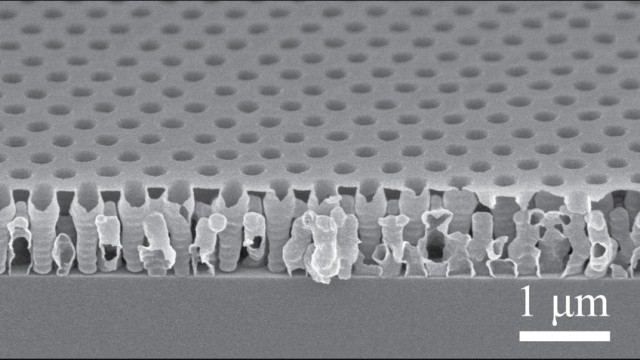A dielectric film that has electronic and optical properties identical to air has been produced. The film is mechanically stable enough to be used in ultra-efficient electronic and photonic devices.
 This image shows the structure of the dielectric film at the micrometer scale. Image credit: Chih-Hao Chang.
This image shows the structure of the dielectric film at the micrometer scale. Image credit: Chih-Hao Chang.
The refractive index is a key material property that measures the magnitude by which light is bent when it passes through a substance. For instance air has a refractive index of 1 whilst water has a refractive index of 1.33. This is the reason straws appear bent when they are submerged in a glass of water.
The different materials used as modular components in photonic devices must have significantly different refractive indices, i.e. some components must have a low refractive index and others must have a high refractive index. The greater the difference in the refractive indices of the components the better the performance of the photonic device.
Air has the lowest refractive index possible, making it a desireable component to team with a high refractive index material, however; it possesses no mechanical stability. In naturally occurring solid materials the lowest refractive index known 1.39.
Now, using aluminum oxide, the researchers at North Carolina State University have grown a film with a very low refractive index of 1.025, almost identical to air, that has high mechanical stability.
By manipulating the structure of the aluminum oxide, which is dielectric, we’ve improved both its optical and mechanical properties.
Prof. Chih-Hao Chang - NC State
Dielectric materials are insulators which are used widely in electronic devices. Handheld device contain many capacitors, which consist of dielectric components capable of storing electric charge.
The key to the film’s performance is the highly-ordered spacing of the pores, which gives it a more mechanically robust structure without impairing the refractive index.
Xu Zhang - NC State
Using a nanolithography method devised in Chang’s lab, the film is created by first forming highly ordered pores in a polymer substrate. The porous polymer material then acts as a template onto which a thin layer of aluminum oxide is coated. Upon burning off the polymer a 3D aluminum oxide coating is left behind.
We are able to control the thickness of the aluminum oxide, creating a coating between two nanometers and 20 nanometers thick. Using zinc oxide in the same process, we can create a thicker coating. And the thickness of the coating controls and allows us to design the refractive index of the film.” Despite the level of thickness of the coating, the film by itself measures about 1nm in thickness.
Xu Zhang - NC State
The steps in the process are potentially scalable, and are compatible with existing chip manufacturing processes. Our next steps include integrating these materials into functional optical and electronic devices.
Prof. Chih-Hao Chang - NC State